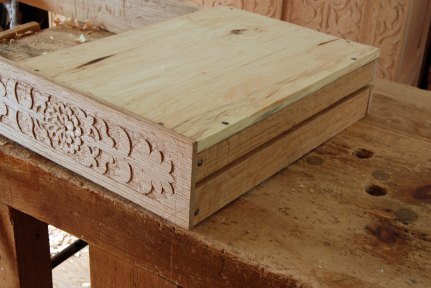I found the nails. they were in the chest’s till; safely stored where I forgot them. After boring pilot holes, I nailed the sides to the front. In most cases, the nails go through the drawer side, into the end grain of the front. They sometimes go through the front, then to be covered by applied moldings. I could have done that, (these drawers will have applied moldings framing them), but the original is nailed this way.
But at the back, the nails go through the back into the end grain of the sides.
Notice in this next photo, the drawer back closes the groove in the sides. So you have to open up a notch for the drawer to engage the runners.
 start with a saw, then a chisel.
start with a saw, then a chisel.
This one’s ready to drive the nails down.
The bottoms run front-to-back. here’s one installed, fitting behind a rabbet in the drawer front, nailed up to the higher edges of the sides & back.
Preliminary test drive of the drawer. Then I took it back out for the rest of the bottom boards.
There’s a false muntin glued onto the drawer front, then moldings surround the “two” drawer fronts. Here, the muntin is just placed there, when I glued it on, I made sure it was straight. Enough. (turned drawer pulls will fit into holes not-yet-bored in the drawer fronts. On to the next drawer.
I hope to post some spoons & boxes for sale tomorrow. we’ll see…
















